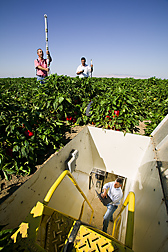This page has been archived and is being provided for reference purposes only. The page is no longer being updated, and therefore, links on the page may be invalid.
|
Read the magazine story to find out more. |
|
|
Perfect Peppers: How Much Water Do They Need?
By Marcia WoodSeptember 22, 2006
Crisp, colorful bell peppers add zest to a breakfast omelet, a salad of fresh greens at dinner—and much more. Agricultural Research Service (ARS) scientists in California, where many of the nation’s bell peppers are grown, are working with colleagues from Israel, Jordan and the Palestinian Authority to determine exactly how much irrigation water a pepper plant needs in order to produce perfect peppers.
The research should benefit both the American West and Middle East where growers compete with city dwellers for clean, fresh water. Giving pepper plants precisely the amount of water they need conserves that natural resource, benefitting growers’ balance sheets and the environment alike.
Agricultural engineer James E. Ayars, with the ARS San Joaquin Valley Agricultural Sciences Center, Parlier, Calif., is helping coordinate the unique collaboration. Though the San Joaquin Valley ranks as the world’s most productive agricultural region, bell peppers are a relatively new crop to its west side—and little is known about the plants’ water needs, according to Ayars.
The Middle Eastern scientists worked with Ayars and Thomas J. Trout, formerly at Parlier and now with ARS at Fort Collins, Colo., to track the plants’ water use at sites that had one of three common types of irrigation systems: furrow, in which water flows down channels between crop rows; surface drip, in which water is delivered to plants a drop at a time via a network of flexible black tubing; and subsurface drip, in which the tubing is buried beneath the surface and the water moves directly to plant roots, where it’s most needed.
Data gathered in these studies will help determine a figure called a "crop coefficient" that can guide farm advisors, irrigation specialists and growers in calculating how much water their pepper crop has used in the previous several days—and deciding how much of that water they should replenish, and when.
Read more about this research in the September 2006 issue of Agricultural Research magazine.
ARS, the U.S. Department of Agriculture’s chief scientific research agency, and the U.S. Department of State are funding the research.


